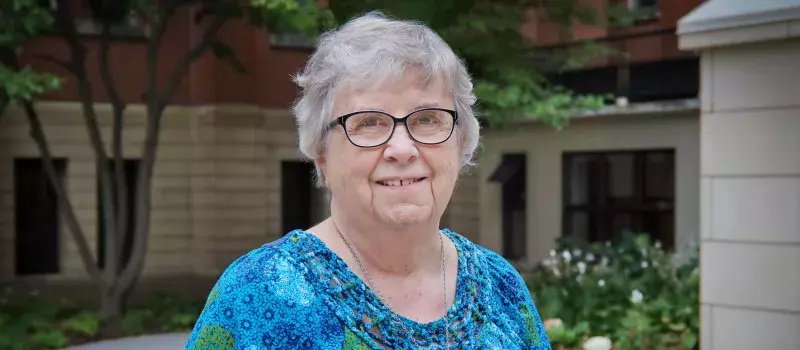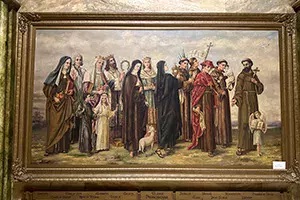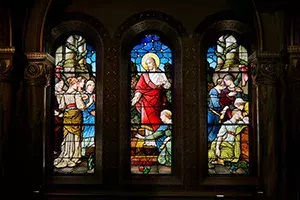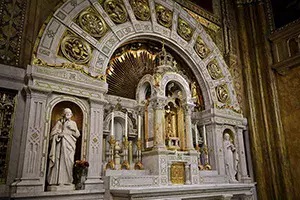My Perspective: Sharing the ministry and beauty of adoration
The glory of God, prayer and artisanship shine in FSPA’s chapels

By Carrie Kirsch, Franciscan Sister of Perpetual Adoration
Mary of the Angels Chapel at St. Rose Convent in La Crosse, Wisconsin, is a remarkable wonder. As the FSPA Chapel Tour Coordinator for eight years, I have come to really appreciate its beauty. I find it speaks to so many people through architecture and the quiet presence in the Adoration Chapel.
As written in our history and honored every year, Mother Antonia Herb, in 1865, with the making of a lard light to illuminate the Blessed Sacrament in their little house at night, made a solemn promise: “Dear Lord, accept this poor light. It is the best we can give you now, but if you will help us and bless the community, we will one day establish Perpetual Adoration of the Blessed Sacrament and build for you as beautiful a chapel as our means will allow.” The sisters kept this promise. In 1878 Perpetual Adoration began in La Crosse. In 1901, our sisters realized that the chapel, located at the time in the St. Rose Complex courtyard, was too small.
It must have been a leap of faith for Mother Ludovica Keller to accept design plans for such a large church from Eugene Leibert, a 35-year-old German-American architect from Milwaukee, Wisconsin, in 1901. Eugene selected a team of artisans he knew and trusted. Most of the craftsmen he sought to help create his vision were educated at the Academy of Fine Arts in Munich, Germany. Chapel construction was largely completed between 1902 and 1906.
How fortunate it was that master woodcarver and sculptor Egid Hackner, who founded the E. Hackner Company of La Crosse in 1881, was chosen to do much of the interior work. With the encouragement of his older brother, a priest in the Diocese of La Crosse, Egid came to the United States from Munich, Germany. Located in the corridor leading to the chapel a sedilia — bench seating crafted in that era for priests and acolytes — is a great example of his company’s work.
The red oak hardwood is hand carved, as electricity was not accessible until after the chapel was built. The sedilia’s detailed beading and faces of angels and the Christ Child are so well done. I have not yet found anyone who can explain how its row of beads was crafted.
Before I lead our guests into Mary of the Angels Chapel, we study the oil painting of the Franciscan saints created by Sister Cleta Bakewell. Sister Cleta entered the FSPA community in 1911 with very little artistic training, yet sketched and painted the large, intricate piece. As we stand before her painting, our visitors and I take time to share the Franciscan roots of Saints Francis, Clare and Rose of Viterbo. Many of our guests are interested in learning that Viterbo University, the FSPA-sponsored institution in La Crosse, was named after the Italian city that Saint Rose lived in.



Among the highlights inside the chapel are the stained glass windows. All the windows throughout the chapel were made in Bavaria, Germany, at the Franz Xaver Zettler Studio. Many on the architect team knew of the studio and its excellent work. In the early days, windows were a great teaching tool for studying their faith. At the window in Mary of the Angels that depicts the Parable of the Wise and Foolish Virgins with their oil lamps, I invite any of our visitors who know the biblical story to tell it. Often they will spot little details in the window and are delighted to understand what a good teaching tool the imagery in the windows can be.
Our chapel is full of faith stories. For example, there are 10 life-size statues carved and placed on transept pillars: four Old Testament prophets, four Doctors of the Church and Saints Peter and Paul — saints the Catholic Church recognizes for significant contributions of research, study or writings of theology or doctrine. Following Eugene’s suggestion for the statues, a carver from an eastern state eagerly volunteered to create them. This artisan requested that the statues be “one of a kind” by disposing of any molds used in the design, insisting he not be paid or be given credit for his work. What a gift!
Egid had his men undertake the practice of building altars made of beautiful, Italian marble instead of wood. The tedious work of cutting the Venetian glass and mother of pearl shells that are edged into the marble adds to their beauty. The crucifix above the tabernacle sits on a revolving platform. On the other side is the monstrance, which contains the Blessed Sacrament and also sits on the same revolving platform. FSPA has, throughout our history, held community-wide holy hours, during which the monstrance faces the congregation.
After the tour, our guests enter the Adoration Chapel for a brief, quiet prayer time. We hear many wonderful and touching reactions from visitors after touring the Mary of the Angels and Perpetual Adoration Chapels, upholding our ministries of adoration and Franciscan hospitality.
